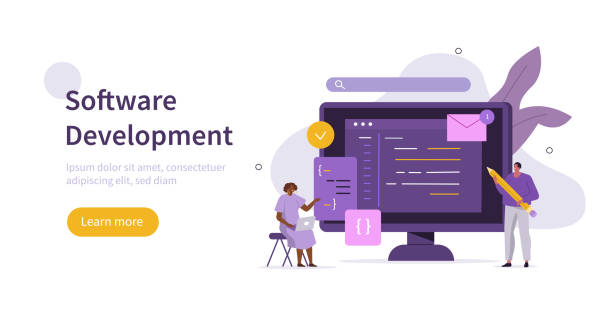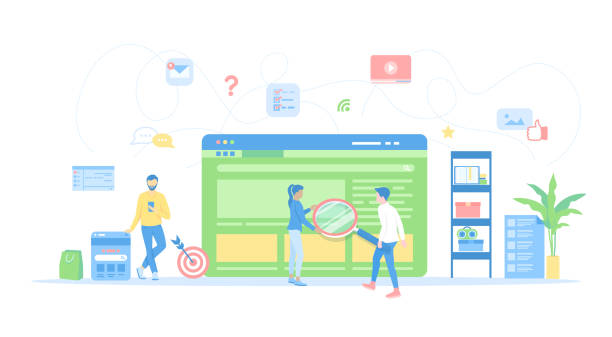The Importance of Secure Website Design in the Digital Age

In today’s world, where all aspects of our lives are intertwined with the internet, #Website_Security and the protection of #User_Data have become a critical challenge.
Every day, we witness an increase in #Cyber_Attacks on websites and online systems, which can lead to the disclosure of sensitive information, data destruction, and even widespread financial losses.
Secure website design is no longer a luxury; it is an undeniable necessity. This concept not only includes technical aspects but also human and procedural dimensions.
Insecure websites can quickly erode user trust and severely damage a business’s reputation.
For instance, in recent years, numerous reports of data breaches from large websites have been published, leading to irreparable consequences for companies and their users.
This indicates that investing in secure website design is, in fact, an investment in the long-term sustainability and success of an online project.
From the perspective of website security, all layers, from network infrastructure to application coding and data management, must be carefully reviewed and protected.
This comprehensive approach, also known as Defense in Depth, ensures that even if one layer is breached, other layers can protect the system.
Therefore, understanding the fundamental principles of secure website design is essential for every developer, web administrator, and even ordinary user to protect themselves in this high-risk digital environment.
This section serves as an explanatory and educational introduction, highlighting the importance of this topic.
Are you bothered by losing customers due to your online store’s outdated appearance or slow speed? Rasaweb’s expert team solves these problems with professional online store design!
✅ Increase customer trust and brand credibility
✅ Blazing fast speed and excellent user experience
Get a free consultation with Rasaweb right now ⚡
Understanding the Most Common Web Vulnerabilities

To achieve a secure website design, we must first understand our adversaries.
There are numerous #Web_Vulnerabilities that attackers exploit to infiltrate systems.
Among the most well-known is #SQL_Injection, where an attacker injects malicious SQL code through input fields into the database, extracting or manipulating sensitive information.
This type of attack can lead to complete data loss or exposure of confidential information.
Another very common vulnerability is #Cross-Site_Scripting (XSS).
In this attack, the attacker injects malicious JavaScript code into the website, which is executed in the victim’s browser and can steal cookies, session information, or other user data.
Cross-Site Request Forgery (CSRF) attacks are also serious threats where an attacker tricks a user into sending unwanted requests to a trusted website.
The OWASP (Open Web Application Security Project) organization publishes a list of the Top 10 web application vulnerabilities every few years, which is a valuable resource for developers and security professionals.
Familiarity with these vulnerabilities and understanding how they work is the first step in countering and preventing attacks.
This specialized section focuses on identifying and explaining these common threats to provide the necessary foundation for subsequent discussions on secure website design.
Awareness of these vulnerabilities helps developers prioritize security considerations when coding and implementing features, preventing these issues from arising.
This knowledge is a vital part of a comprehensive security strategy.
Secure Coding Solutions and Attack Prevention

#Secure_Coding is the backbone of a secure website design.
By adhering to specific principles and techniques during the development phase, the occurrence of vulnerabilities can be significantly prevented.
One of the most important principles is strict #Input_Validation.
All data entered by the user into the system must be checked and validated without exception, in terms of type, format, and length.
This prevents the injection of malicious code or unauthorized data.
Using Prepared Statements and parameterized queries in the database is the best solution for combating SQL Injection attacks.
These methods ensure that user inputs are treated as data, not as part of SQL commands.
To counter XSS, all outputs must be properly filtered and encoded before being displayed to the user so that malicious code is interpreted as plain text.
#Session_Management is also of high importance.
Sessions must be securely generated, maintained, and expired.
Using CSRF tokens in forms is essential to prevent Cross-Site Request Forgery attacks.
Additionally, the Principle of Least Privilege must be observed; meaning each user or service should only have access to the resources and functionalities necessary for performing their tasks.
These guidance-oriented and educational approaches form the foundation of any secure website design project.
Furthermore, using modern web development frameworks that inherently support many of these security mechanisms can significantly reduce the burden on developers and help build more secure applications.
Keeping libraries and frameworks up-to-date is also crucial, as new versions often include security patches for discovered vulnerabilities.
| Security Solution | Targeted Vulnerability | Brief Description |
|---|---|---|
| Input Validation | SQL Injection, XSS, Path Traversal | Thoroughly checking input data for type, format, and size to prevent injection of malicious code. |
| Using Parameterized Queries | SQL Injection | Separating data from SQL commands to prevent user input from being interpreted as code. |
| Output Encoding | Cross-Site Scripting (XSS) | Converting special characters in output to HTML entities to prevent execution of malicious scripts. |
| Secure Session Management | Session Hijacking, Session Fixation | Using random and secure tokens for sessions, regular expiration, and protection against session hijacking attacks. |
| CSRF Tokens | Cross-Site Request Forgery (CSRF) | Adding unique and hidden tokens to requests to ensure their authenticity. |
The Vital Role of SSL/TLS Certificates in Web Security

In the discussion of secure website design, encrypting data in transit is of particular importance.
#HTTPS, the secure version of #HTTP, achieves this using #SSL/TLS (Secure Sockets Layer/Transport Layer Security) certificates.
SSL/TLS are protocols that encrypt communication between the user’s browser and the website server, preventing eavesdropping, tampering, or forgery of information during transmission.
When a website uses HTTPS, a green padlock or the word “Secure” is displayed in the browser’s address bar, indicating the security of the connection and reassuring users.
Choosing an appropriate SSL certificate (whether Domain Validation – DV, Organization Validation – OV, or Extended Validation – EV) depends on the needs and desired level of trust.
EV certificates offer the highest level of identity verification.
Furthermore, using HTTPS also benefits SEO; Google prefers websites that use HTTPS in its search results rankings.
This not only helps user security but also leads to increased website traffic and credibility.
Correct SSL/TLS configuration includes using secure protocols (such as TLS 1.2 or 1.3), strong cipher suites, and disabling deprecated protocols (such as SSL 3.0 or TLS 1.0).
This specialized and explanatory aspect demonstrates the irreplaceable role of encryption in protecting data within the process of secure website design.
Without this protective layer, all sensitive information, including login credentials and credit card details, is exposed to interception and misuse.
Falling behind in the competition with large online stores?
Rasaweb makes your business online with professional e-commerce website design and increases your market share!
✅ Increase brand credibility and customer trust
✅ Easy shopping experience leads to more sales
⚡ Act now for a free website design consultation!
Securing the Database: The Beating Heart of a Website

The database is the primary repository for all sensitive website information, and therefore, #Database_Security is a fundamental pillar of #Secure_Website_Design.
Without adequate database protection, even the most secure coding will be ineffective.
The first step in ensuring security is to use strong and complex passwords for database access, and default or simple passwords must be strictly avoided.
Restricting #Data_Access based on the principle of least privilege, meaning that each application or user only has access to the tables and columns necessary for its function, is crucial.
This can minimize vulnerabilities in case of a breach in one part of the system.
#Encryption of sensitive data in the database, especially financial or personal user information, creates an additional layer of protection; even if an attacker gains access to the data, they will not be able to use it without the decryption key.
Additionally, regular updates of the Database Management System (DBMS) to apply new security patches are very important.
Any insecure default configurations must be identified and corrected.
Continuous monitoring of database activities to detect any suspicious activity or attempted intrusions is also a critical solution.
Regular and secure backups of the database are also vital to enable recovery in the event of ransomware attacks or data destruction.
This guidance-oriented and specialized section emphasizes the importance of protecting a website’s most critical digital asset, its data, within the framework of a comprehensive secure website design.
Using techniques such as database isolation for different systems can significantly reduce risk and greatly contribute to maintaining data integrity and confidentiality.
Implementing Strong Authentication and Authorization Mechanisms

#Authentication and #Authorization are two fundamental pillars in secure website design for managing user access.
Authentication is the process of verifying a user’s identity, while authorization determines what resources and functionalities the authenticated user has access to.
For authentication, using #Strong_Passwords and mandatory policies for periodic password changes are of high importance.
Implementing Two-Factor Authentication (2FA) or Multi-Factor Authentication (MFA) adds a powerful security layer and prevents unauthorized access even if passwords are compromised.
Modern techniques such as using One-Time Passwords (OTP) or Passwordless Login also help increase security.
In terms of authorization, appropriate access control models such as Role-Based Access Control (RBAC) should be used.
In RBAC, users are assigned specific roles (such as administrator, editor, normal user), and each role has a defined set of permissions.
This simplifies access management and reduces configuration errors.
Also, implementing Rate Limiting for login attempts can prevent Brute Force attacks (password guessing).
This educational and analytical section delves into how to implement these mechanisms to ensure a secure website design and precise control over user access.
In this regard, monitoring login patterns and detecting abnormal activities can also help identify intrusion attempts.
Logging all authentication and authorization-related events for subsequent security analysis is also essential.
Web Application Firewalls (WAF) and Intrusion Detection Systems (IDS)

Within the framework of a comprehensive #Secure_Website_Design strategy, the use of layered security solutions such as Web Application Firewalls (#WAF) and Intrusion Detection Systems (#IDS) is essential.
WAFs are positioned at the network edge and analyze and filter HTTP/HTTPS requests before they reach the web application.
They are capable of identifying and blocking common attack patterns such as SQL Injection, XSS, and CSRF.
A WAF can be implemented both as software and hardware, and there are also cloud WAF services (such as Cloudflare WAF) that are easy to use.
These tools play a vital role in protecting web applications against known and even unknown vulnerabilities (Zero-Day Exploits).
On the other hand, #IDSs monitor network traffic and alert if any suspicious activity or anomaly is detected that could indicate an attempted intrusion.
IDSs can be signature-based, which search for patterns of known attacks, or anomaly-based, which identify unusual behaviors.
The combination of WAF and IDS provides a strong defensive approach; the WAF blocks attacks at the application layer, while the IDS focuses on identifying and alerting about suspicious activities in lower network layers or after passing through the WAF.
This specialized and informative section introduces the latest technologies in the field of #Network_Security and their role in completing the secure website design strategy.
These tools act as powerful lines of defense and enable organizations to manage cyber threats more effectively.
| Feature | WAF (Web Application Firewall) | IDS/IPS (Intrusion Detection/Prevention System) |
|---|---|---|
| Primary Focus | Protection at Layer 7 (Application Layer) | Monitoring and protection at network layers (3, 4, and 7) |
| Targeted Traffic Type | HTTP/HTTPS and web application traffic | Various network protocols |
| Main Capability | Filtering and blocking malicious web requests | Detection and (in IPS) prevention of intrusion based on known patterns or anomalies |
| Examples of Mitigated Attacks | SQL Injection, XSS, CSRF, File Inclusion | Port Scans, DoS, Buffer Overflows, Malicious Payload Delivery |
| Architectural Position | Usually in front of web server or reverse proxy | Monitoring point in the network (Inline for IPS) |
The Importance of Security Audits and Periodic Penetration Testing

Even with the best #Secure_Website_Design approaches in the initial development stages, there is a continuous need for security review and evaluation.
#Security_Audit and #Penetration_Testing are two vital tools for identifying vulnerabilities that may emerge over time or due to system changes.
A security audit involves a detailed examination of source code, configurations, policies, and security processes to ensure that best practices are followed and no security weaknesses exist.
This process can be performed manually or using automated tools.
Penetration testing, however, goes a step further; in this process, a specialized team (Penetration Testers) attempts to ethically and in a controlled manner discover and exploit system vulnerabilities like a real attacker.
The goal is to identify and fix system weaknesses before malicious attackers do.
The results of penetration testing include a comprehensive report of discovered vulnerabilities, how they were exploited, and corrective solutions.
Periodic performance of these tests and audits is essential for any website, especially those processing sensitive information.
This analytical and guidance-oriented approach significantly contributes to ensuring #Proactive_Security and the stability of a secure website design.
Organizations should consider these activities as an integral part of their Software Development Life Cycle (SDLC), carrying them out not only before launch but also regularly and after any major system changes.
This continuous process helps maintain security against constantly evolving cyber threats.
Are you losing potential customers due to an unprofessional website? Rasaweb is your answer! With our specialized corporate website design services:
✅ Enhance your business’s credibility and standing
✅ Experience attracting more targeted customers
⚡ Act now for a free consultation!
Incident Response and Disaster Recovery Planning

Even with the strongest secure website design and best protective protocols, the likelihood of a security incident never reaches zero.
Therefore, having an #Incident_Response_Plan and a #Disaster_Recovery_Plan is crucial for any organization or individual operating a website.
An incident response plan is a set of defined procedures and steps to follow in the event of a cyber attack or data breach.
This plan includes steps for incident identification, containment, eradication, recovery, and finally, lessons learned to prevent similar incidents in the future.
The main goal is to minimize damage, quickly restore services, and preserve the organization’s reputation.
#Disaster_Recovery also focuses on restoring system functionality after a catastrophic event such as data loss, natural disasters, or widespread cyber attacks.
This plan includes details on regular and secure data backups, backup storage locations (such as cloud or off-site), and procedures for recovering systems and data.
It is questionable why some organizations still underestimate these plans, while their absence can lead to business bankruptcy.
This educational and thought-provoking section emphasizes the importance of anticipating and preparing for worst-case scenarios to ensure #Data_Protection and business continuity in today’s high-risk digital world.
Regular practice and review of these plans are as important as their formulation, as the cyber threat landscape is constantly changing, and plans must be updated accordingly.
The Future of Secure Website Design and Emerging Trends

As technology advances, cyber threats also become more complex and intelligent.
Therefore, #Secure_Website_Design is not a static process but requires continuous adaptation to emerging trends.
One of the most important upcoming trends is the use of #Artificial_Intelligence (AI) and Machine Learning (ML) in cybersecurity.
These technologies can identify attack patterns with unprecedented speed and accuracy and even predict new and unknown threats.
The use of AI in WAFs, IDSs, and log analysis tools can elevate website security to a new level.
The discussion around #Quantum_Security is also heating up.
With the advent of quantum computers capable of breaking current encryptions, developing post-quantum cryptography algorithms will be essential for future data protection.
The increasing number of Internet of Things (IoT) devices and their connection to websites pose new security challenges; ensuring #Secure_IoT_Security alongside websites guarantees the integrity of connected systems.
Additionally, the use of blockchain in some security applications, such as decentralized authentication and identity management, holds great potential.
This analytical and engaging section looks at the future of secure website design and explores how security tools, techniques, and approaches will evolve to meet upcoming challenges.
Preparing for these changes and investing in new technologies will be key to maintaining data integrity and confidentiality in the digital age to come.
Frequently Asked Questions
| Row | Question | Answer |
|---|---|---|
| 1 | What is secure website design? | Secure website design is a process in which websites are built with security measures in mind from the initial stages of development to protect against cyber attacks, unauthorized access, and data loss. |
| 2 | Why is secure website design important? | Website security is vital for maintaining user trust, protecting sensitive information (personal and financial), preventing brand reputation damage, and complying with privacy and security regulations (such as GDPR). Security breaches can lead to financial and legal damages. |
| 3 | What are the most common cyber attacks a website faces? | Some of the most common attacks include SQL Injection, Cross-Site Scripting (XSS), Distributed Denial of Service (DDoS), Brute Force, and credential-based attacks (Credential Stuffing). |
| 4 | What is SQL Injection and how to prevent it? | SQL Injection is a type of attack where an attacker attempts to manipulate the database or extract information by injecting malicious SQL code into website inputs. To prevent it, one should use Prepared Statements/Parameterized Queries, ORM (Object-Relational Mapping), and strict input validation. |
| 5 | What is Cross-Site Scripting (XSS)? | XSS is a type of attack where an attacker injects malicious scripts (usually JavaScript) into web pages that are then executed by other users’ browsers. This can lead to the theft of cookies, session information, or alteration of the website’s appearance. |
| 6 | How can Brute Force attacks on login pages be prevented? | To prevent Brute Force attacks, one should use CAPTCHA, limit the number of failed login attempts (Account Lockout), Two-Factor Authentication (2FA), and use complex and long passwords. |
| 7 | What is the role of HTTPS in website security? | HTTPS encrypts the communication between the user’s browser and the website server using SSL/TLS. This prevents eavesdropping, tampering, or forgery of information during transmission and increases user trust. |
| 8 | What is the importance of Input Validation in security? | Input Validation is the process of checking and sanitizing data entered by the user. This prevents the injection of malicious code, XSS attacks, SQL Injection, and other vulnerabilities, ensuring that the data conforms to the expected format. |
| 9 | Why is regular updating of website systems and software essential? | Regular updates of the operating system, CMS (like WordPress), plugins, themes, and libraries used address known security vulnerabilities. Hackers often exploit weaknesses in outdated software for intrusion. |
| 10 | What role does regular backup play in secure website design? | Regular and tested backups of website data (database and files) provide a crucial layer of defense against data loss due to cyber attacks, human errors, or hardware failures. This enables rapid website recovery in the event of a disaster. |
And other advertising services of Rasaweb Advertising Agency
Creating perfume sales ads with a focus on local productions
The importance of high-quality images in perfume ads for business directories
SEO techniques to improve perfume ad ranking
How perfume manufacturers can build customer trust in ads
Using special offers in perfume sales ads
And over a hundred other services in internet advertising, advertising consultation, and organizational solutions
Internet Advertising | Advertising Strategy | Advertorial
🚀 Ready to transform your business in the digital world? Rasaweb Afarin Digital Marketing Agency, with its expertise in professional website design and SEO, offers innovative solutions for your growth and visibility.
📍 Tehran, Mirdamad Street, next to Bank Markazi, Kazerun Jonubi Alley, Ramin Alley, No. 6



